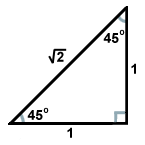Today in the class we learn more briefly about the special angles of the Unit Circle.Most angles on the Unit Circle are basically multiples of the special angles which are 0° ,30°(π/6),45°(π/4) ,60° (π/3) ,90°(π/2).We also learned How to fill out the chart of special angles.First special angles and quadrantal angles could be found using Reference Triangles which we learned in the last class.
Let say now you want to find the trig values for 225°(5π/4). Look at the chart above and see which one has same denominator values in radian measure.In this case it is 45°(π/4).Copy down all the values of trig functions SinӨ ,CosӨ ,TanӨ.Keeping the CAST rule in mind you should know what are the signs of trig functions.225° angle is found in Ouadrant 3. SinӨ and CosӨ are negative in Quadrant 3 and TanӨ is positive.Signs will change in some of the cases.Because Trig values signs are different in different quadrants.
We also learn how to find the coordinates for P(Ө).
Example.1
a) P(π/4)
To make it easy set up isosceles right triangle on the Unit Circle.It will look like this.
Find the SinӨ(π/4) and CosӨ(π/4)
SinӨ= O/H and CosӨ=A/H
SinӨ =1/√2
CosӨ=1/√2
Therefore P(π/4) =(1/√2,1/√2).
Last thing we learn is finding exact values.
Ex no.2
a) Tan 150°
It is kind of same as above example.
Set up the right triangle on unit circle.
find values of SinӨ and CosӨ Which are 1/2 and √3/2
TanӨ = SinӨ/CosӨ
= Which will give us 1/√2.
Mr P also told us to fill up the Unit circle. If you want to check if you did it right Click on the link below.
Don't forget to do homework.
Ex.3,Questions 1,2,10-12 and worksheet.
See u all tomorrow.

![]()






 .
.








